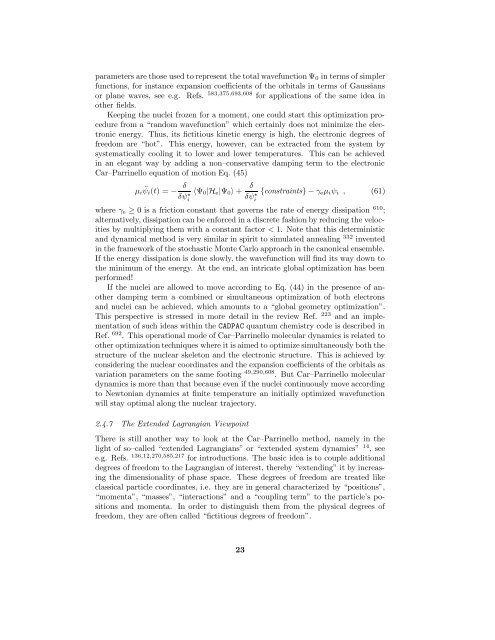Ab initio molecular dynamics: Theory and Implementation
Ab initio molecular dynamics: Theory and Implementation
Ab initio molecular dynamics: Theory and Implementation
- No tags were found...
You also want an ePaper? Increase the reach of your titles
YUMPU automatically turns print PDFs into web optimized ePapers that Google loves.
parameters are those used to represent the total wavefunction Ψ 0 in terms of simplerfunctions, for instance expansion coefficients of the orbitals in terms of Gaussiansor plane waves, see e.g. Refs. 583,375,693,608 for applications of the same idea inother fields.Keeping the nuclei frozen for a moment, one could start this optimization procedurefrom a “r<strong>and</strong>om wavefunction” which certainly does not minimize the electronicenergy. Thus, its fictitious kinetic energy is high, the electronic degrees offreedom are “hot”. This energy, however, can be extracted from the system bysystematically cooling it to lower <strong>and</strong> lower temperatures. This can be achievedin an elegant way by adding a non–conservative damping term to the electronicCar–Parrinello equation of motion Eq. (45)µ i ¨ψi (t) = − δδψ ⋆ i〈Ψ 0 |H e |Ψ 0 〉 + δδψ ⋆ i{constraints} − γ e µ i ψ i , (61)where γ e ≥ 0 is a friction constant that governs the rate of energy dissipation 610 ;alternatively, dissipation can be enforced in a discrete fashion by reducing the velocitiesby multiplying them with a constant factor < 1. Note that this deterministic<strong>and</strong> dynamical method is very similar in spirit to simulated annealing 332 inventedin the framework of the stochastic Monte Carlo approach in the canonical ensemble.If the energy dissipation is done slowly, the wavefunction will find its way down tothe minimum of the energy. At the end, an intricate global optimization has beenperformed!If the nuclei are allowed to move according to Eq. (44) in the presence of anotherdamping term a combined or simultaneous optimization of both electrons<strong>and</strong> nuclei can be achieved, which amounts to a “global geometry optimization”.This perspective is stressed in more detail in the review Ref. 223 <strong>and</strong> an implementationof such ideas within the CADPAC quantum chemistry code is described inRef. 692 . This operational mode of Car–Parrinello <strong>molecular</strong> <strong>dynamics</strong> is related toother optimization techniques where it is aimed to optimize simultaneously both thestructure of the nuclear skeleton <strong>and</strong> the electronic structure. This is achieved byconsidering the nuclear coordinates <strong>and</strong> the expansion coefficients of the orbitals asvariation parameters on the same footing 49,290,608 . But Car–Parrinello <strong>molecular</strong><strong>dynamics</strong> is more than that because even if the nuclei continuously move accordingto Newtonian <strong>dynamics</strong> at finite temperature an initially optimized wavefunctionwill stay optimal along the nuclear trajectory.2.4.7 The Extended Lagrangian ViewpointThere is still another way to look at the Car–Parrinello method, namely in thelight of so–called “extended Lagrangians” or “extended system <strong>dynamics</strong>” 14 , seee.g. Refs. 136,12,270,585,217 for introductions. The basic idea is to couple additionaldegrees of freedom to the Lagrangian of interest, thereby “extending” it by increasingthe dimensionality of phase space. These degrees of freedom are treated likeclassical particle coordinates, i.e. they are in general characterized by “positions”,“momenta”, “masses”, “interactions” <strong>and</strong> a “coupling term” to the particle’s positions<strong>and</strong> momenta. In order to distinguish them from the physical degrees offreedom, they are often called “fictitious degrees of freedom”.23









